事件语义学理论与汉英句式的语义表征_从_王冕死了父亲_说起
- 格式:pdf
- 大小:209.99 KB
- 文档页数:5
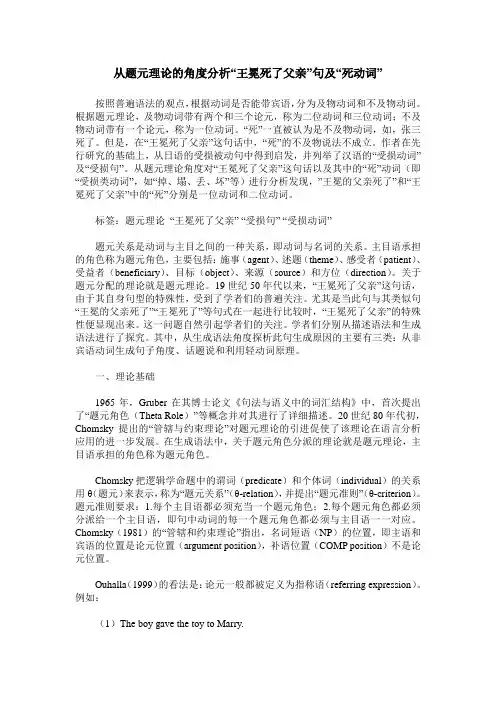
从题元理论的角度分析“王冕死了父亲”句及“死动词”按照普遍语法的观点,根据动词是否能带宾语,分为及物动词和不及物动词。
根据题元理论,及物动词带有两个和三个论元,称为二位动词和三位动词;不及物动词带有一个论元,称为一位动词。
“死”一直被认为是不及物动词,如,张三死了。
但是,在“王冕死了父亲”这句话中,“死”的不及物说法不成立。
作者在先行研究的基础上,从日语的受损被动句中得到启发,并列举了汉语的“受损动词”及“受损句”。
从题元理论角度对“王冕死了父亲”这句话以及其中的“死”动词(即“受损类动词”,如“掉、塌、丢、坏”等)进行分析发现,”王冕的父亲死了”和“王冕死了父亲”中的“死”分别是一位动词和二位动词。
标签:题元理论“王冕死了父亲” “受损句” “受损动词”题元关系是动词与主目之间的一种关系,即动词与名词的关系。
主目语承担的角色称为题元角色,主要包括:施事(agent)、述题(theme)、感受者(patient)、受益者(beneficiary)、目标(object)、来源(source)和方位(direction)。
关于题元分配的理论就是题元理论。
19世纪50年代以来,“王冕死了父亲”这句话,由于其自身句型的特殊性,受到了学者们的普遍关注。
尤其是当此句与其类似句“王冕的父亲死了”“王冕死了”等句式在一起进行比较时,“王冕死了父亲”的特殊性便显现出来。
这一问题自然引起学者们的关注。
学者们分别从描述语法和生成语法进行了探究。
其中,从生成语法角度探析此句生成原因的主要有三类:从非宾语动词生成句子角度、话题说和利用轻动词原理。
一、理论基础1965年,Gruber在其博士论文《句法与语义中的词汇结构》中,首次提出了“题元角色(Theta Role)”等概念并对其进行了详细描述。
20世纪80年代初,Chomsky提出的“管辖与约束理论”对题元理论的引进促使了该理论在语言分析应用的进一步发展。
在生成语法中,关于题元角色分派的理论就是题元理论,主目语承担的角色称为题元角色。
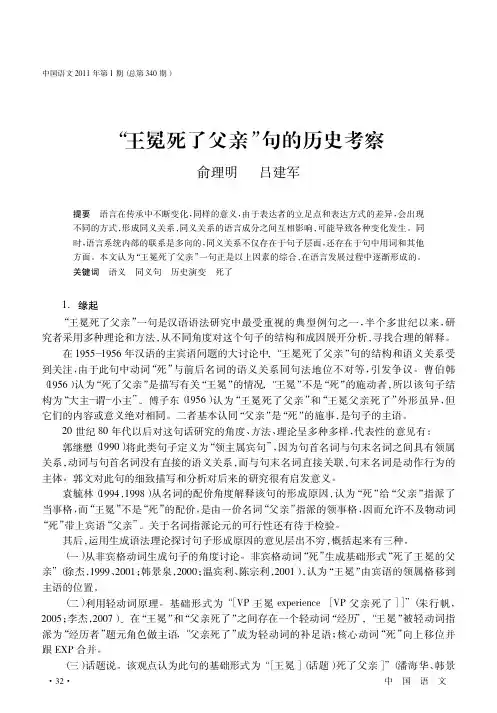
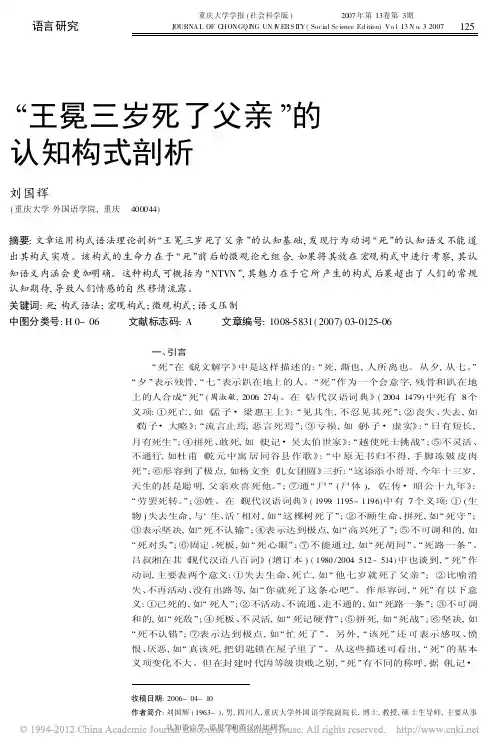
语言研究重庆大学学报(社会科学版)2007年第13卷第3期J OURNAL OF CHONGQI NG UN I VERS I TY(Soci al Science Ed iti on)Vo l113N o132007收稿日期:2006-04-10作者简介:刘国辉(1963-),男,四川人,重庆大学外国语学院副院长,博士,教授,硕士生导师,主要从事认知语言学、语用学和英汉对比研究。
/王冕三岁死了父亲0的认知构式剖析刘国辉(重庆大学外国语学院,重庆400044)摘要:文章运用构式语法理论剖析/王冕三岁死了父亲0的认知基础,发现行为动词/死0的认知语义不能道出其构式实质。
该构式的生命力在于/死0前后的微观论元组合,如果将其放在宏观构式中进行考察,其认知语义内涵会更加明确。
这种构式可概括为/NTVN0,其魅力在于它所产生的构式后果超出了人们的常规认知期待,导致人们情感的自然移情流露。
关键词:死;构式语法;宏观构式;微观构式;语义压制中图分类号:H0-06文献标志码:A文章编号:1008-5831(2007)03-0125-06一、引言/死0在《说文解字》中是这样描述的:/死,澌也,人所离也。
从夕,从七。
0/夕0表示残骨,/七0表示趴在地上的人。
/死0作为一个会意字,残骨和趴在地上的人合成/死0(周淑敏,2006:274)。
在《古代汉语词典》(2004:1479)中死有8个义项:①死亡,如《孟子#梁惠王上》:/见其生,不忍见其死0;②丧失、失去,如《荀子#大略》:/流言止焉,恶言死焉0;③亏损,如《孙子#虚实》:/日有短长,月有死生0;④拼死、敢死,如《史记#吴太伯世家》:/越使死士挑战0;⑤不灵活、不通行,如杜甫《乾元中寓居同谷县作歌》:/中原无书归不得,手脚冻皴皮肉死0;⑥形容到了极点,如杨文奎《儿女团圆》三折:/这添添小哥哥,今年十三岁,天生的甚是聪明,父亲欢喜死他。
0;⑦通/尸0(尸体),《左传#昭公十九年》:/劳罢死转。
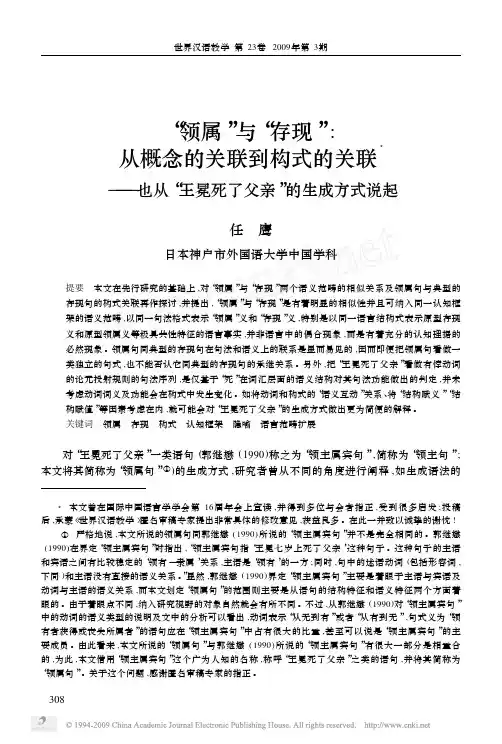
“领属”与“存现”:从概念的关联到构式的关联3———也从“王冕死了父亲”的生成方式说起任 鹰日本神户市外国语大学中国学科提要 本文在先行研究的基础上,对“领属”与“存现”两个语义范畴的相似关系及领属句与典型的存现句的构式关联再作探讨,并提出,“领属”与“存现”是有着明显的相似性并且可纳入同一认知框架的语义范畴,以同一句法格式表示“领属”义和“存现”义,特别是以同一语言结构式表示原型存现义和原型领属义等极具共性特征的语言事实,并非语言中的偶合现象,而是有着充分的认知理据的必然现象。
领属句同典型的存现句在句法和语义上的联系是显而易见的,因而即便把领属句看做一类独立的句式,也不能否认它同典型的存现句的承继关系。
另外,把“王冕死了父亲”看做有悖动词的论元投射规则的句法序列,是仅基于“死”在词汇层面的语义结构对其句法功能做出的判定,并未考虑动词词义及功能会在构式中发生变化。
如将动词和构式的“语义互动”关系、将“结构赋义”“结构赋值”等因素考虑在内,就可能会对“王冕死了父亲”的生成方式做出更为简便的解释。
关键词 领属 存现 构式 认知框架 隐喻 语言范畴扩展对“王冕死了父亲”一类语句(郭继懋(1990)称之为“领主属宾句”,简称为“领主句”;本文将其简称为“领属句”①)的生成方式,研究者曾从不同的角度进行阐释,如生成语法的8033①本文曾在国际中国语言学学会第16届年会上宣读,并得到多位与会者指正,受到很多启发;投稿后,承蒙《世界汉语教学》匿名审稿专家提出非常具体的修改意见,获益良多。
在此一并致以诚挚的谢忱!严格地说,本文所说的领属句同郭继懋(1990)所说的“领主属宾句”并不是完全相同的。
郭继懋(1990)在界定“领主属宾句”时指出,“领主属宾句指‘王冕七岁上死了父亲’这种句子。
这种句子的主语和宾语之间有比较稳定的‘领有—隶属’关系,主语是‘领有’的一方;同时,句中的述语动词(包括形容词,下同)和主语没有直接的语义关系。
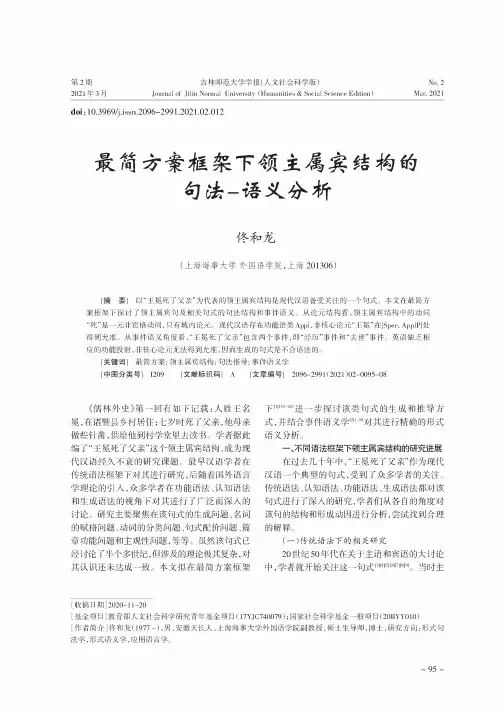
第2期2021年3月吉林师范大学学报(人文社会科学版)Journal of Jilin Normal University(Humanities&Social Science Edition)No.2Mar.2021doi:10.3969/j.issn.2096-2991.2021.02.012最简方案框架下领主属宾结构的句法-语义分析佟和龙(上海海事大学外国语学院,上海201306)「摘要]以“王冕死了父亲”为代表的领主属宾结构是现代汉语备受关注的一个句式。
本文在最简方案框架下探讨了领主属宾句及相关句式的句法结构和事件语义。
从论元结构看,领主属宾结构中的动词“死”是一元非宾格动词,只有域内论元。
现代汉语存在功能语类Appl,非核心论元“王冕”在「Spec,ApplP]处得到允准。
从事件语义角度看,“王冕死了父亲”包含两个事件,即“经历”事件和“去世”事件。
英语缺乏相应的功能投射,非核心论元无法得到允准,因而生成的句式是不合语法的。
「关键词]最简方案;领主属宾结构;句法推导;事件语义学「中图分类号]I209「文献标识码]A「文章编号]2096-2991(2021)02-0095-08《儒林外史《第一回有如下记载:人姓王名冕,在诸暨县乡村居住;七岁时死了父亲,他母亲做些针黹,供给他到村学堂里去读书。
学者据此编了“王冕死了父亲”这个领主属宾结构,成为现代汉语经久不衰的研究课题。
最早汉语学者在传统语法框架下对其进行研究,后随着国外语言学理论的引入,众多学者在功能语法、认知语法和生成语法的视角下对其进行了广泛而深入的讨论。
研究主要聚焦在该句式的生成问题、名词的赋格问题、动词的分类问题、句式配价问题、篇章功能问题和主观性问题,等等。
虽然该句式已经讨论了半个多世纪,但涉及的理论极其复杂,对其认识还未达成一致。
本文拟在最简方案框架下W。
1进一步探讨该类句式的生成和推导方式,并结合事件语义学「2,1-50对其进行精确的形式语义分析。
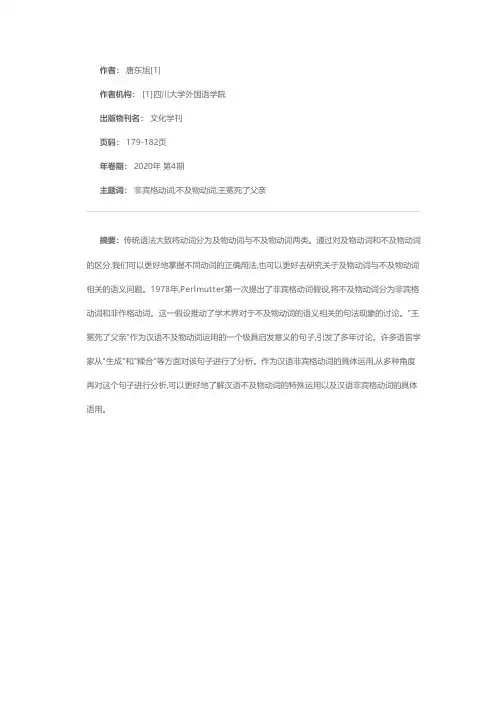
作者: 唐东旭[1]
作者机构: [1]四川大学外国语学院
出版物刊名: 文化学刊
页码: 179-182页
年卷期: 2020年 第4期
主题词: 非宾格动词;不及物动词;王冕死了父亲
摘要:传统语法大致将动词分为及物动词与不及物动词两类。
通过对及物动词和不及物动词的区分,我们可以更好地掌握不同动词的正确用法,也可以更好去研究关于及物动词与不及物动词相关的语义问题。
1978年,Perlmutter第一次提出了非宾格动词假设,将不及物动词分为非宾格动词和非作格动词。
这一假设推动了学术界对于不及物动词的语义相关的句法现象的讨论。
"王冕死了父亲"作为汉语不及物动词运用的一个极具启发意义的句子,引发了多年讨论。
许多语言学家从"生成"和"糅合"等方面对该句子进行了分析。
作为汉语非宾格动词的具体运用,从多种角度再对这个句子进行分析,可以更好地了解汉语不及物动词的特殊运用以及汉语非宾格动词的具体语用。
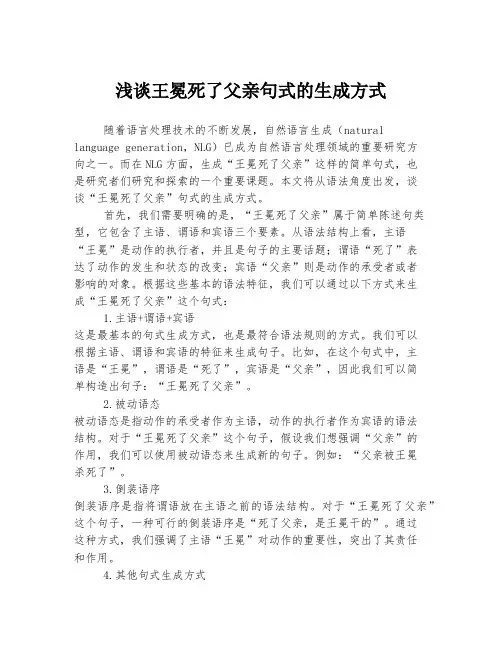
浅谈王冕死了父亲句式的生成方式随着语言处理技术的不断发展,自然语言生成(natural language generation,NLG)已成为自然语言处理领域的重要研究方向之一。
而在NLG方面,生成“王冕死了父亲”这样的简单句式,也是研究者们研究和探索的一个重要课题。
本文将从语法角度出发,谈谈“王冕死了父亲”句式的生成方式。
首先,我们需要明确的是,“王冕死了父亲”属于简单陈述句类型,它包含了主语、谓语和宾语三个要素。
从语法结构上看,主语“王冕”是动作的执行者,并且是句子的主要话题;谓语“死了”表达了动作的发生和状态的改变;宾语“父亲”则是动作的承受者或者影响的对象。
根据这些基本的语法特征,我们可以通过以下方式来生成“王冕死了父亲”这个句式:1.主语+谓语+宾语这是最基本的句式生成方式,也是最符合语法规则的方式。
我们可以根据主语、谓语和宾语的特征来生成句子。
比如,在这个句式中,主语是“王冕”,谓语是“死了”,宾语是“父亲”,因此我们可以简单构造出句子:“王冕死了父亲”。
2.被动语态被动语态是指动作的承受者作为主语,动作的执行者作为宾语的语法结构。
对于“王冕死了父亲”这个句子,假设我们想强调“父亲”的作用,我们可以使用被动语态来生成新的句子。
例如:“父亲被王冕杀死了”。
3.倒装语序倒装语序是指将谓语放在主语之前的语法结构。
对于“王冕死了父亲”这个句子,一种可行的倒装语序是“死了父亲,是王冕干的”。
通过这种方式,我们强调了主语“王冕”对动作的重要性,突出了其责任和作用。
4.其他句式生成方式此外,还可以通过省略、并列、分句等方式来生成新的句式。
比如,“王冕的父亲去世了”这个句子,可以通过省略动词“死了”来产生。
而“王冕和他的父亲一起离开了人世”这个句子,则是将句子中的宾语拆分成了两个并列宾语,通过类比生成而来。
总的来说,句式的生成是一个复杂的过程,需要考虑语义、语法、话题等多方面因素。
在生成“王冕死了父亲”这个句子时,我们可以根据不同要求,采用不同的语法结构和表达方式,从而实现语言的差异化和个性化。
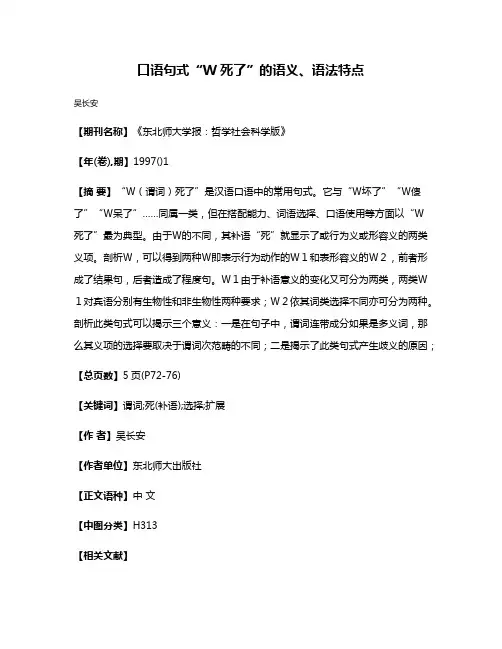
口语句式“W死了”的语义、语法特点
吴长安
【期刊名称】《东北师大学报:哲学社会科学版》
【年(卷),期】1997()1
【摘要】“W(谓词)死了”是汉语口语中的常用句式。
它与“W坏了”“W傻了”“W呆了”……同属一类,但在搭配能力、词语选择、口语使用等方面以“W死了”最为典型。
由于W的不同,其补语“死”就显示了或行为义或形容义的两类义项。
剖析W,可以得到两种W即表示行为动作的W1和表形容义的W2,前者形成了结果句,后者造成了程度句。
W1由于补语意义的变化又可分为两类,两类W1对宾语分别有生物性和非生物性两种要求;W2依其词类选择不同亦可分为两种。
剖析此类句式可以揭示三个意义:一是在句子中,谓词连带成分如果是多义词,那么其义项的选择要取决于谓词次范畴的不同;二是揭示了此类句式产生歧义的原因;【总页数】5页(P72-76)
【关键词】谓词;死(补语);选择;扩展
【作者】吴长安
【作者单位】东北师大出版社
【正文语种】中文
【中图分类】H313
【相关文献】
1.对“X死了”句式的语义分析--从“我病死了”谈起 [J], 黄蕾
2."VA死了"结构的语义语法分析 [J], 胡献献
3.事件语义学理论与汉英句式的语义表征——从"王冕死了父亲"说起 [J], 黄洁
4.从句式语法看被字句的句式语义属性 [J], 严玉培
5.语义与结构——从两种句式的相互转换看语义在语法分析中的作用 [J], 常丹阳;因版权原因,仅展示原文概要,查看原文内容请购买。
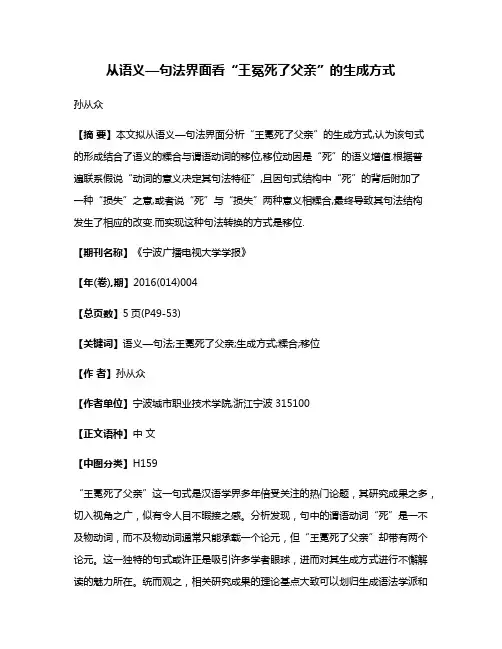
从语义—句法界面看“王冕死了父亲”的生成方式孙从众【摘要】本文拟从语义—句法界面分析“王冕死了父亲”的生成方式,认为该句式的形成结合了语义的糅合与谓语动词的移位,移位动因是“死”的语义增值.根据普遍联系假说“动词的意义决定其句法特征”,且因句式结构中“死”的背后附加了一种“损失”之意,或者说“死”与“损失”两种意义相糅合,最终导致其句法结构发生了相应的改变.而实现这种句法转换的方式是移位.【期刊名称】《宁波广播电视大学学报》【年(卷),期】2016(014)004【总页数】5页(P49-53)【关键词】语义—句法;王冕死了父亲;生成方式;糅合;移位【作者】孙从众【作者单位】宁波城市职业技术学院,浙江宁波315100【正文语种】中文【中图分类】H159“王冕死了父亲”这一句式是汉语学界多年倍受关注的热门论题,其研究成果之多,切入视角之广,似有令人目不暇接之感。
分析发现,句中的谓语动词“死”是一不及物动词,而不及物动词通常只能承载一个论元,但“王冕死了父亲”却带有两个论元。
这一独特的句式或许正是吸引许多学者眼球,进而对其生成方式进行不懈解读的魅力所在。
统而观之,相关研究成果的理论基点大致可以划归生成语法学派和认知语法学派,其核心观点分别为移位和语义糅合。
两大学派的假设和阐释可谓仁者见仁,智者见智。
基于此,本文拟将两个学派的核心观点加以整合,并用语义—句法界面的理论视角进行分析,但求我们的一孔之见有助于学界找到解读这一句式的答案。
“王冕死了父亲”的研究主要可分为两大类:生成语法学派的移位说和认知语法学派的糅合说。
(一)生成语法学派的观点针对“王冕死了父亲”这类结构,生成语法学派的学者们利用乔姆斯基不同时期的理论框架、原则和方法从不同角度对其进行了分析。
主要有“移位说”和“深层主格说”,而移位法又分移NP和移动词两种。
徐杰(1999)和韩景泉(2000)从领有名词提升移位方向的视角作出假设,认为“王冕死了父亲”这一句子的基础形式为“死了王冕的父亲”。
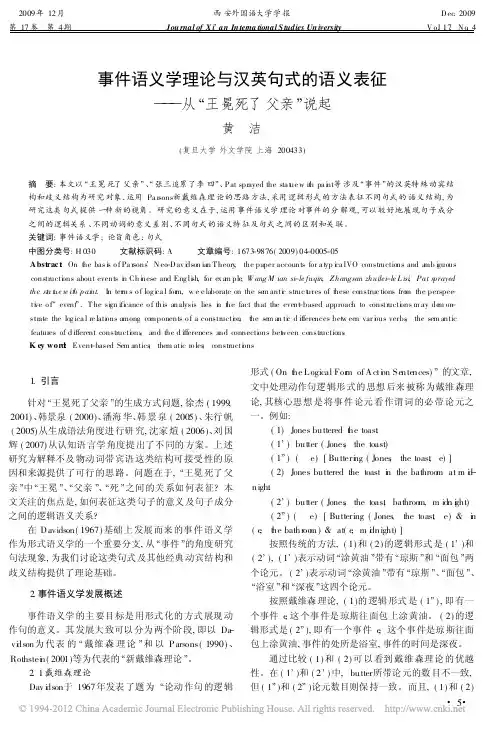
2009年12月西安外国语大学学报D ec.2009第17卷第4期Jou rnal of X i.an In ter na tional S tudies Un iversity V o.l17.N o.4事件语义学理论与汉英句式的语义表征)))从/王冕死了父亲0说起黄洁(复旦大学外文学院上海200433)摘要:本文以/王冕死了父亲0、/张三追累了李四0、P at sprayed the sta t ue w it h pa i nt等涉及/事件0的汉英特殊动宾结构和歧义结构为研究对象,运用Pa rsons新戴维森理论的思路方法,采用逻辑形式的方法表征不同句式的语义结构,为研究这类句式提供一种新的视角。
研究的意义在于,运用事件语义学理论对事件的分解观,可以较好地展现句子成分之间的逻辑关系、不同动词的意义差别、不同句式的语义特征及句式之间的区别和关联。
关键词:事件语义学;论旨角色;句式中图分类号:H030文献标识码:A文章编号:1673-9876(2009)04-0005-05Abstrac t:On t he bas i s o f Pa rsons.N eo-D av i dson ian T heory,the paper accounts for a t yp i ca lVO constructions and a mb i guous constructi ons about events i n Ch i nese and Eng li sh,for ex a m ple,W ang M ian si-le fuqin,Zhangsan zhuilei-le L isi,Pat sp rayed the st a t ue w it h p ai nt.In ter m s o f log i ca l for m,w e e laborate on the se m anti c struc t ures of t hese construc tions fro m the perspec-ti ve o f/event0.T he si gn ifi cance o f this analysis lies i n t he fact that the event-based approach to constructi ons m ay de m on-strate the log ica l re lati ons among components o f a constructi on,t he se m an ti c d ifferences bet w een var i ous verbs,the sem antic features of d ifferent constructi ons,and the d ifferences and connecti ons bet ween constructions.K ey word:Event-based Sem antics;them atic ro les;constructi ons1.引言针对/王冕死了父亲0的生成方式问题,徐杰(1999, 2001)、韩景泉(2000)、潘海华、韩景泉(2005)、朱行帆(2005)从生成语法角度进行研究,沈家煊(2006)、刘国辉(2007)从认知语言学角度提出了不同的方案。
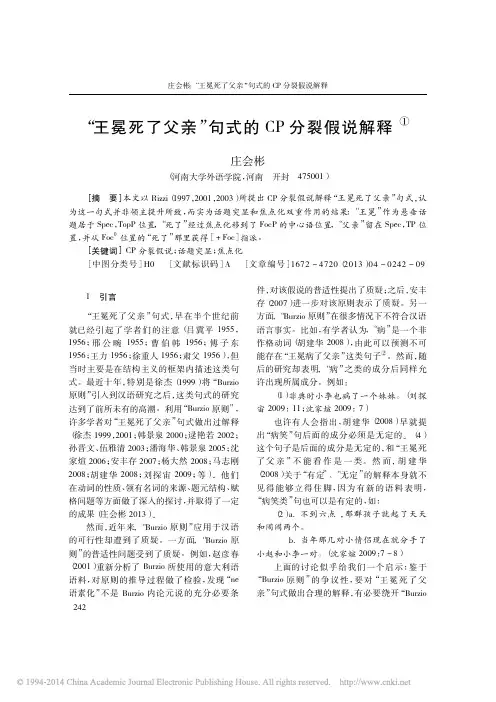
对领主属宾句的句式分析作者:晏羽来源:《学习与科普》2019年第04期摘要:"王冕死了父亲"这一句子有众多学者对此进行了研究,如吕冀平、王力、沈家煊、石毓智、帅志嵩、杨大然等。
他们或者从生成语法的左向合并,或者是利用糅合观点来分析,都成一定角度分析了这一句式的生成机制。
本文从论元、双向因果链和构式语义三个角度进行分析。
关键词:论元双向因果链构式语义从上世纪50年代开始,一些语言学家开始关注“王冕死了父亲”这一类句式,并对此展开一系列研究和讨论。
以“王冕死了父亲”为代表的领主属宾句是语言学界讨论了近半个世纪的现象。
各个学派都对这类句子进行过比较详尽的描述和解释,尤以形式派居多,如徐杰( 1999; 2001)、韩景泉( 2000)、温宾利和陈宗利( 2001)等。
针对这个句式,我们可以从论元角度、双向因果链和构式语义这三个方面进行分析。
一.从论元角度对“王冕死了父亲”的分析“死”一般都被认为是不及物动词.但“王冕死了父亲”这句话引起了不少语言学家的关注。
为什么“死”会有这种用法呢?从表层结构上来看,不及物动词占据着中心地位,是支配成分。
从深层结构来看.不及物动词表示动作或状态,与从属词组组成一个意义自足的主谓结构。
论元对于选择它的述渭来说很关键,是不可缺少的,原因在于它构成了述谓表示的意义的一个组成部分。
不同动词有不同数目的论元.这是由动词的词汇性决定的。
动词根据论元数目的多少.可分为一元动词、二元动词和三元动词。
简单地将“死”定义为一元动词,说服力不是很强。
本文将试着给予解释。
比较下面三句话:(1)王冕死了父亲。
(2)王冕的父亲死了。
(3)王冕死了。
我们很容易发现,(1)中“王冕死了父亲”和(2)、(3)中的“死”所蕴涵的意味是不同的。
(2)和(3)陈述事实,分别讲“王冕的父亲”失去了生命和“王冕”失去了生命。
而在(1)中,“王冕”并没有失去生命;是“父亲”失去了生命。
这句话整体上向我们传达的意思是:王冕的父亲死了,这个事实给活着的王冕带来了不好的后果。
再谈“王冕死了父亲”的句式构成吴晶【期刊名称】《河北民族师范学院学报》【年(卷),期】2012(032)004【摘要】The generative grammar is explanatory, but it must be supported by linguistic material from de scriptive grammar so that it can fully reveal cognation; meanwhile, though descriptive grammar turns out to be concrete, only with the help of theory of formal linguistics can it become alive. The Chinese sentence "Wang Mi an sile fuqin" (Wang Mian Lost His Father) can be well accounted for, with cooperation of descriptive and gener ative grammar. The widespread phenomenon of syntactic and semantic mismatch shown by subjects of some Chi nese verbs and the transitiveness of some intransitive verbs both contribute to the formation of the sentence dis cussed by this article.%生成语法预备解释力,但是必须有来自于描写语法的语料支撑才能充分揭示认知,而描写语法固然显得步步为营,但有了形式语言学的理论才能做到画龙点睛。
2009年12月西安外国语大学学报D ec.2009第17卷第4期Jou rnal of X i.an In ter na tional S tudies Un iversity V o.l17.N o.4事件语义学理论与汉英句式的语义表征)))从/王冕死了父亲0说起黄洁(复旦大学外文学院上海200433)摘要:本文以/王冕死了父亲0、/张三追累了李四0、P at sprayed the sta t ue w it h pa i nt等涉及/事件0的汉英特殊动宾结构和歧义结构为研究对象,运用Pa rsons新戴维森理论的思路方法,采用逻辑形式的方法表征不同句式的语义结构,为研究这类句式提供一种新的视角。
研究的意义在于,运用事件语义学理论对事件的分解观,可以较好地展现句子成分之间的逻辑关系、不同动词的意义差别、不同句式的语义特征及句式之间的区别和关联。
关键词:事件语义学;论旨角色;句式中图分类号:H030文献标识码:A文章编号:1673-9876(2009)04-0005-05Abstrac t:On t he bas i s o f Pa rsons.N eo-D av i dson ian T heory,the paper accounts for a t yp i ca lVO constructions and a mb i guous constructi ons about events i n Ch i nese and Eng li sh,for ex a m ple,W ang M ian si-le fuqin,Zhangsan zhuilei-le L isi,Pat sp rayed the st a t ue w it h p ai nt.In ter m s o f log i ca l for m,w e e laborate on the se m anti c struc t ures of t hese construc tions fro m the perspec-ti ve o f/event0.T he si gn ifi cance o f this analysis lies i n t he fact that the event-based approach to constructi ons m ay de m on-strate the log ica l re lati ons among components o f a constructi on,t he se m an ti c d ifferences bet w een var i ous verbs,the sem antic features of d ifferent constructi ons,and the d ifferences and connecti ons bet ween constructions.K ey word:Event-based Sem antics;them atic ro les;constructi ons1.引言针对/王冕死了父亲0的生成方式问题,徐杰(1999, 2001)、韩景泉(2000)、潘海华、韩景泉(2005)、朱行帆(2005)从生成语法角度进行研究,沈家煊(2006)、刘国辉(2007)从认知语言学角度提出了不同的方案。
上述研究为解释不及物动词带宾语这类结构可接受性的原因和来源提供了可行的思路。
问题在于,/王冕死了父亲0中/王冕0、/父亲0、/死0之间的关系如何表征?本文关注的焦点是,如何表征这类句子的意义及句子成分之间的逻辑语义关系?在D avidson(1967)基础上发展而来的事件语义学作为形式语义学的一个重要分支,从/事件0的角度研究句法现象,为我们讨论这类句式及其他经典动宾结构和歧义结构提供了理论基础。
2.事件语义学发展概述事件语义学的主要目标是用形式化的方式展现动作句的意义。
其发展大致可以分为两个阶段,即以Da-vi dson为代表的/戴维森理论0和以P arsons(1990)、Rothstei n(2001)等为代表的/新戴维森理论0。
2.1戴维森理论Dav i dson于1967年发表了题为/论动作句的逻辑形式(On t he L ogical For m of A ct i on Se nte nces)0的文章,文中处理动作句逻辑形式的思想后来被称为戴维森理论,其核心思想是将事件论元看作谓词的必带论元之一。
例如:(1)Jones buttered t he toast.(1.)butter(Jones,the toast)(10)(Èe)[Butteri ng(Jones,the toast,e)](2)Jones buttered the toast i n the bathroo m at m i d-night.(2.)butter(Jones,the toast,bathroo m,m idn i ght)(20)(Èe)[Buttering(Jones,the toast,e)&i n (e,t he bathr oo m)&at(e,m i dnight)]按照传统的方法,(1)和(2)的逻辑形式是(1.)和(2.),(1.)表示动词/涂黄油0带有/琼斯0和/面包0两个论元。
(2.)表示动词/涂黄油0带有/琼斯0、/面包0、/浴室0和/深夜0这四个论元。
按照戴维森理论,(1)的逻辑形式是(10),即有一个事件e,这个事件是琼斯往面包上涂黄油。
(2)的逻辑形式是(20),即有一个事件e,这个事件是琼斯往面包上涂黄油,事件的处所是浴室,事件的时间是深夜。
通过比较(1)和(2)可以看到戴维森理论的优越性。
在(1.)和(2.)中,butter所带论元的数目不一致,但(10)和(20)论元数目则保持一致。
而且,(1)和(2)的蕴涵关系无法通过(1.)和(2.)展现,却能通过(10)和(20)体现。
2.2新戴维森理论Parsons等在继承D avidson(1967)对动作句处理思路的基础上,提出了新戴维森理论。
新戴维森理论最大的特点是对个体参与者的单独量化,将事件看作元素(prm i iti ves),将论旨角色(the m at i c roles)看作事件与个体(i ndivi dua ls)的关系。
它与戴维森理论的不同之处在于,论旨角色被引入逻辑式,并单独描述每个个体和事件的关系。
按照新戴维森理论,(2)的逻辑式为(2.0),即:(2)Jones buttered the toast i n the bathroo m at m i d-n i ght.(2.0)Èe[Butteri ng(e)&A gent(e,Jones)& T he me(e,the toast)&i n(e,the bathroo m)&at(e, m i dnight)]这个逻辑式的意思是,存在一个事件e,它是关于涂黄油的,事件的施事是琼斯,客体是面包,事件发生的地点是浴室,时间是深夜。
比较(20)和(2.0)可以看出,按照新戴维森理论,事件e涉及的各个论元被分离出来,单独描述他们与事件的关系。
这样处理的好处是,能更好体现句子之间的蕴涵关系,不被提及的论旨角色可以在逻辑式中不予描述,不至于使必带论元不被提及时也要被描述。
(3)和(4)的区别体现出新戴维森理论的优越性。
按照戴维森理论,(3)和(4)的逻辑形式分别是(3.)和(4.)¹。
按照P arsons的新戴维森理论,引入论旨角色,将各个独立而关联的角色用合取的关系连接起来,(3)和(4)的逻辑形式分别改为(30)和(40),(4)中因不涉及客体x,故逻辑形式中对客体不予描述,这样,(3)和(4)的蕴涵关系能通过(30)和(40)体现。
(3)Brutus stabbed Caesar.(3.)(Èe)[Sta bb i ng(e,Br utus,Caesar)](30)(Èe)[Sta bb i ng(e)&Cu l(e)&A gent(e, Brutus)&T he m e(e,Caesar)](4)Brutus stabbed.(4.)(Èe)[Sta bb i ng(e,Br utus,x)](40)(Èe)[Stabbi ng(e)&Cul(e)&Agent(e, Brutus)]新戴维森理论的另一个代表是Rothstei n(2001, 2004a,2004b),她主要用加合操作(su mm i ng operati on)的形式处理次级谓语(secondary predicate)的问题,包括描述性谓语(depictive predication)(例如,T he po li ce ar-rested Johni drunk.i)和结果性谓语(resultative predica-t i on)(例如,M ary pa i nted the housei red.i)。
因R othste i n 和P arsons在处理动作句的逻辑形式问题上采取类似的处理方法,这里不作详细论述。
3.事件语义学对各类句法结构的解释力事件语义学理论的特点在于,可以通过逻辑形式的方式,清晰展现句子的意义。
运用新戴维森理论的思想,可以用逻辑形式表征汉语和英语中许多句式的语义结构,由此展现不同类型动词的用法区别、句子成分之间基于/事件0而形成的关联、及不同句式的意义差别和联系。
3.1不及物动词带宾语结构不及物动词带宾语在汉语中很常见。
吕叔湘(1980:60)指出,/动词和宾语的关系更加是多种多样,有的得用许多话才说得清楚。
同一个-跑.字,-跑街、跑码头、跑江湖、跑天津.是说在哪些地方跑来跑去,-跑买卖.是为什么目的而跑,-跑警报.是为什么原因而跑, -跑单帮、跑龙套.是以什么身份而跑,-跑马.是让马为自己服务,-跑腿.是自己为别人服务,-跑电、跑水.是拦不住某种东西跑掉,-跑肚.是拦不住肚子里的东西跑掉0。
汉语中/死0、/来0、/坏0等不及物动词可带宾语,例如,(5)(6)(7)中的句子分别表示消极意义、积极意义和中性意义。
(5)a.王冕死了父亲。
b.他坏了两个牙。
(6)a.他家来了客人。
b.他长了几分勇气。
(7)a.他起了一身鸡皮疙瘩。
b.北京城来了个李自成。
针对/王冕死了父亲0这类句式的生成问题,徐杰(参见图1)、朱行帆(参见图2)提出了移位的观点,认为是/王冕0或/死0移位的结果。